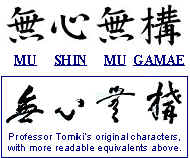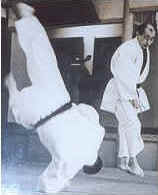|
MU
SHIN, MU
GAMAE
MUSHIN Empty
Mind, Not thinking, Without
Conscience, Without emotion
Mindless, Endless, No-mind-ness
MUGAMAE
Without posture, Without stance
No posture, No attitude-ness
|

|
|
A
philosophical concept that lies in the heart of Tomiki's Budo,
"Mushin Mugamae." "Mushin" is a state in which
the mind lets go from itself, no longer seeing things as
"this and that, good and bad, right and wrong, gain and loss,
life and death-all which must be seen as a oneness."
"Mushin" is a mind undisturbed by effects of any kind
from which proceeds a "flowing mind and body" and making
possible the performance of skilful technique without
"conscious efforts made to generate and sustain it."
Mushin is the Zen concept of “no mindedness,” a state
in which there is no preconceived thought that interrupts the flow
of physical action. Mu
means “nothing, empty, or no.”
Shin means “mind or heart” in both the physical and in
the spiritual sense. Thus in terms of Zen, there is no separation
between thought and emotion.
To feel it is to think it; to think it is to feel it.
The
corollary of "Mushin" is "Mugamae", the body
adopting the posture or stance appropriate to any situation
without the conscious direction of the mind.
With
no preconceived thought or emotion, action will be one with
thought and emotion. Thus
to think it and to feel it is to do it.
A circle is always balanced.
There is no distinguishing top or bottom, left or right.
It has no point or goal but to be a circle.
The planet Saturn represents the eternal rotation of the
solar system. Should
the planet cease to rotate, it will be destroyed, and harmony will
cease in the universe. The
planets affect the tides, the never-ending flow of water.
Should the oceans cease to flow, stagnation will occur.
Stagnation in the physical world and in our personal lives
will bring about defeat in martial arts and in life.
The planet Saturn is bound by its rings, which represent
constraint and control. The
planet Saturn in harmony with the universe and its own
self-contained cosmos, therefore, represents the mindless circle.
Training in martial arts is meaningless unless it leads to
the continual perfection of the practitioner, despite the outside
forces of negativity and darkness that constantly work in
opposition to spirituality and the light of hope.
Thus the way of Mushin Mugamae is “the way of the
mindless (endlessness) circle.”
There is not always a specific goal in a martial arts
technique or in life. In
most martial arts systems, the techniques have an “end in
mind.” Too often
the goal is to hurt or maim an opponent.
These techniques can also be easily countered, leaving the
practitioner with no options.
The circle stops. But
a technique designed to be a means of achieving harmony with an
opponent’s flow has many options.
Since the technique has not been predetermined, it will be
difficult to defend against.
Because the end is not in the martial artist’s mind, it
does not exist until created in response to the flow of combat.
Also in reaction to an opponent’s attack, a strike can
become a block; a block can become a strike, with or without
power. A strike can
even turn into a pat on a potential opponent’s back should the
moment of conflict be eliminated prior to a physical
confrontation. The
correct technique will occur when the martial artist is in the
flow of the mindless circle.
A momentary defeat is only a chance to create another
artistic endeavour based upon achieving the harmony contained in
the mindless circle. Even
in defeat if a martial artist is in the flow of the endless
circle, the defeat can become a means to spiritual and physical
regeneration. The
defeat becomes a victory, and the circle is completed.
Even
in life’s every day endeavours, many individuals always look for
ends or achievements and often lose sight of the means necessary
to attain those goals. A
missed opportunity in life is merely a chance for those
individuals to aspire to another—perhaps more
exciting—achievement that would never have been realized had
their original goals been attained.
Thus no antagonist and no political or social force can
prevail in an attempt to thwart their attainment.
But the problem is that many times those same individuals
have looked only forward to that far off goal, and they failed to
create the short-term means that would help them achieve that end.
Unless they develop the skills necessary to achieve that
goal, the goal will never come.
If the perfection of a particular martial arts technique is
a goal, it is first necessary to develop the timing, balance,
speed, and power needed for proper execution.
A
Zen proverb states something to this effect:
“Those who wish to attain certain goals must first become
certain men or women; once they have attained that state-- become
those certain men or women-- the attainment of that certain goal
will no longer concern them.”
|



